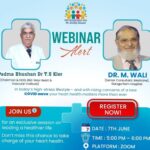healthysoch
New Delhi, March 07, 2019 :
On the occasion of Women’s day, Dr KK Aggarwal, Padma Shri Awardee tells women how to be healthy and what are the risk factors that women should watch out for:
- Heart disease is the leading cause of death in women. More women die of heart disease than all the seven cancers known to occur in women. Unfortunately, the level of awareness of heart disease is much lower compared to cancer. Hence, women are not diagnosed or treated as aggressively as men
- Some heart disease risk factors are unique to women, including postmenopausal status, prior hysterectomy, oral contraceptive use and pregnancy and its complications.
- Heart disease in women has a worse prognosis. Women tend to develop heart disease about a decade later in life than men, but their outcomes are often worse than in men.
- Warning signs of a heart attack in women differ from those in men. Although the most common symptom of heart attack is chest pain or discomfort, women are more likely to have pain in the jaw, neck or back (between the shoulder blades), unexplained weakness or fatigue or they may present with symptoms like shortness of breath, cough, dizziness or nausea. This often results in misdiagnosis and delay in treatment.
Patients aged ≥20 years without established heart disease should undergo periodic cardiovascular risk assessment every three to five years. Periodic risk assessment offers the opportunity to identify heart disease risk factors and offer guidance on the appropriate management of specific risk factors (dietary modifications for hypertension or dyslipidemia) and overall risk of heart disease (maintaining a healthy diet, regular exercise). The choice of a specific risk model for heart disease risk assessment should be individualized based on patient-specific characteristics (age, gender, ethnicity).
- Vaccines that women need: Human Papillomavirus (HPV) vaccine; seasonal flu (influenza) vaccine; varicella vaccine, Measles, Mumps, Rubella (MMR); Tetanus, Diphtheria, Pertussis (Td/Tdap), Herpes zoster vaccine, Pneumococcal vaccine
All female children aged 9 months to 15 years should receive an additional dose of Measles-Rubella vaccination (MR Vaccine). Rubella during pregnancy can cause severe birth defects in the newborn.
Routine HPV vaccination for females should be given at 11 to 12 years of age but can be administered starting at 9 years. Catch-up vaccination should be offered for females aged 13 to 26 years who have not been previously vaccinated. The HPV vaccine can prevent cervical cancer.
- All pregnant women and their husbands should get an HIV test done. HIV can be prevented in the child with the treatment available today.
- Women are at greater risk of osteoporosis. The risk of developing osteoporosis is increased in postmenopausal women because of the decline in estrogen, which protects bones. Lifestyle measures should be adopted to reduce bone loss in postmenopausal women. Lifestyle measures include adequate dietary calcium and vitamin D, exercise (such as walking, running, weight lifting, stair climbing), quit smoking, counselling on fall prevention, limit caffeine intake and avoidance of alcohol. Get bone density test done.
In general, 1200 mg of elemental calcium daily, total diet plus supplement, and 800 international units of vitamin D daily are advised. Postmenopausal women who are getting adequate calcium from a dietary intake alone do not need to take calcium supplements. If dietary intake is inadequate, calcium supplementation is recommended.
- Birth control options: Women should be encouraged to select one of the most effective contraceptive options as per their individual needs.
The most effective contraceptive methods are long-acting reversible contraception (LARC: intrauterine contraception and contraceptive implants) and sterilization. These methods are associated with the lowest pregnancy rates regardless of the population studied because their effectiveness is minimally influenced by the patient’s actions or adherence.
Women, who desire reversible contraception, should go for LARC. Pregnancy rates are comparable to sterilization with the highest satisfaction and continuation rates.
Women who request sterilization should be counselled about LARC as well because LARC is comparable to sterilization in terms of effectiveness, but is nonsurgical and reversible.
For couples who desire permanent contraception (sterilization), prefer vasectomy of the male partner. Vasectomy is as effective, but less morbid and less costly than tubal occlusion.
- Depression is more common in women. The factors increasing the risk of depression are hormonal fluctuations (pregnancy, fertility, menopause and menstrual cycle), social factors such as coping skills, choice of relationships and lifestyle choices. Various forms of depression in women include major depression (a severe form of depression), postpartum depression, premenstrual dysphoric disorder. The following factors are also risk factors of depression in women:
- Death of a parent before age 10
- Job loss, relationship problems, divorce
- Physical or sexual abuse during childhood
- History of mood disorders
- Use of certain medications
More women suffer from the seasonal affective disorder in winter, which is recurring depression with seasonal onset and remission.
- Eat a healthy diet rich infruits, vegetables, whole grains and low-fat dairy products. Women of all ages need to eat iron-rich foods to avoid iron deficiency anaemia. All women of childbearing age should include adequate folic acid (vitamin B) in the diet to reduce the risk of neural tube defects or other birth defects in their children. Calcium-rich foods are important for healthy bones and teeth. Avoid saturated fats, trans fats and sugar-sweetened beverages.
- Maintain a healthy body weight: A healthy body weight can reduce your risk of diseases such as heart disease, stroke, type 2 diabetes, osteoporosis and cancer.
Waist circumference is a measurement of abdominal obesity and provides risk information that is not accounted for by body mass index (BMI). Patients with abdominal obesity (also called central adiposity, visceral, Android, or male-type obesity) are at increased risk for heart disease, diabetes, hypertension, dyslipidemia, and nonalcoholic fatty liver disease. A waist circumference of ≥80 cm in women is considered elevated and indicative of increased cardiometabolic risk. In individuals with BMI ≥22.5 kg/m2 or a waist circumference ≥80 cm go for a further evaluation to assess overall risk status.
- Be physically active: Regular physical activity and exercise is good physical and mental health. It helps maintain healthy body weight, muscle strength and relieves stress. It also reduces the risk for chronic disease conditions such as heart disease, type 2 diabetes, metabolic syndrome, dyslipidemia. Walk for at least 30 minutes daily five days of the week.
The American Heart Association (AHA) recommends at least 150 minutes per week of moderate-intensity aerobic activity (at least 30 minutes of moderate-intensity aerobic activity at least 5 days per week) or 75 minutes per week of vigorous aerobic activity, or a combination of both, preferably spread throughout the week. Spend less time sitting.
(Reproduced from: https://boldoutline.in/womens-day-special-top-tips-for-womens-health.html)
Dr KK Aggarwal : Padma Shri Awardee , President Heart Care Foundation of India
healthy soch







